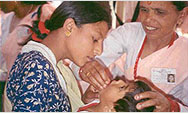Repositioning in Action E-Bulletin
August 2008
Subscribe | Past Issues | Tell Your Story | French Translation
Using Reproductive Health Subaccounts to Advocate for Increased Resources for Family Planning
A reproductive health (RH) subaccount is a tool designed to track shifts in family planning (FP) and RH financing. To know whether budgetary commitments to FP/RH are being honored, it is necessary to track how and where the government, donors, and households actually spend their money.
What is a RH subaccount?
RH subaccounts are expenditure reviews that follow the globally accepted National Health Accounts (NHA) framework¹ to track the flows of funds (public, private, and donor spending) for RH. While the general NHA framework tracks overall health spending in a given country, the subaccounts shed light on specific areas of concern to national policymakers. They are called “sub”accounts because they are usually conducted as part of a general NHA estimation. As with the general NHA, subaccounts should be conducted on a regular basis, although perhaps less frequently (i.e., every 2-3 years) compared with the general NHA (ideally every 1-2 years).
Why are RH subaccounts important?
The subaccounts address critical policy questions. Like the general NHA, they answer:
- Who finances RH?
- How much do they spend?
- Where do these funds go?
- In terms of managers of funds
- In terms of services/products rendered
In addition, the subaccounts can answer more specific policy questions, such as:
- What is the burden of financing on households to pay for family planning? Does income level affect utilization?
- Does the country have a dependency on donors to finance RH care and programs?
- What is the involvement of the informal sector, such as traditional healers, and street vendors?
- What is the progress of contracting with the private sector for the priority area in question?
- How is spending linked to outcomes (e.g., investment per couple year protection)?
Equipped with this information, government planners, donors, as well as advocacy organizations are well placed to “reposition” family planning within national policies and budgets, and to ensure its long-term and sustainable financing.
How did Rwanda use the RH subaccount?
Rwanda was the first country to pioneer the use of RH subaccounts in 2002. The results showed donors financed 80 percent of all RH spending in the country, leading the Ministry of Health (MOH) in Rwanda to advocate for increased domestic support (funding for RH from the central government budget, which may include budget support from the international community) for RH. By 2006, when Rwanda conducted its next RH subaccount analysis, the amount of domestic support had increased from $1 million to $2.8 million (in 2006 dollars). A majority of these funds were used for maternal and child health programs. However, the level of funding for FP commodities managed by the Government of Rwanda also increased from approximately $212,000 to $744,000 in 2006 dollars.
Figure 1: Tracking expenditures on family planning commodities with reproductive health subaccount , Rwanda
 |
2002 total expended on commodities (adjusted to 2006 dollars):
$757,096
|
 |
 |
2006 total expended on commodities:
$2.7 million
*In constant 2006 currency |
-------------------------------------------------------------------------------------------------------------------------------------------------------------
Source: Rwandan Ministry of Health, United States Agency for International Development, World Health Organization, National University of Rwanda School of Public Health. 2008. Rwanda 2006 National Health Accounts Report. Kigali, Rwanda.
Note: OC=oral contraceptive, RWF=Rwandan franc, MoH=Ministry of Health, NGO=nongovernmental organization |
|
Further analysis of the RH subaccount identified the following three reasons behind the increased spending on FP commodities:
- Donor spending: An increase in donor resources, which was channeled through nongovernmental organizations (NGOs) and the MOH, was one driver behind the rise in FP spending. Donor spending on RH increased from $10.1 to $13.6 million between 2002 and 2006.
- Performance-based financing: The Government of Rwanda introduced a policy to increase access to and use of modern methods by rewarding health facilities for serving new and continuing clients.
- Mutual health organizations: Increased coverage by mutual health organizations reduced the financial burden on houses at the point of use. These mutual health organizations are currently undergoing a scale-up that showed 49 percent of the population was enrolled in these community insurance schemes at the end of 2005 – a percentage which had been growing rapidly throughout the 2006 estimation.
The priority the government placed on FP led to an increase in overall spending on FP commodities, and to a decrease in the relative and absolute spending shouldered by households. The fact that households in this low-income country still spend limited out-of-pocket health funds on FP commodities shows that demand for birth spacing is well established.
The results from the 2002 and 2006 Rwanda subaccounts allow one to compare expenditures on FP relative to other priority areas prior to and following the expansion of large-scale global health initiatives such as the Global Fund to Fight AIDS, Tuberculosis and Malaria. Despite the increase in absolute spending levels on FP, the 2006 subaccount reveals that RH lost relative priority financially. This finding confirms anecdotal and other accounts indicating that expenditures on disease-specific initiatives are growing far faster than expenditures on FP. Results from the 2006 RH subaccount underscore the need for FP/RH champions to continue to advocate for increased resources for FP/RH programs.
To date, RH subaccounts have been or are currently being conducted in Ethiopia, Georgia, India (Karnataka state), Jordan, Kenya, Liberia, Malawi, Mali, Mexico, Rwanda, Senegal, Tanzania, Uganda, and Ukraine. Those contributed to by Health Systems 20/20 or its predecessor project PHRplus are available at http://www.healthsystems2020.org/.
The Methodological Guidelines to Producing Reproductive Health Subaccounts is in the prepublication phase and will soon be available on the Health Systems 20/20 Web site (URL listed above).
The 2006 Rwanda National Health Accounts Report, which includes RH subaccounts, is available at http://www.healthsystems2020.org/content/resource/detail/1992/
------------------------
¹ Conducted in more than 100 countries. Endorsed by WHO, World Bank, Health Metrics Network, USAID, Sida, and other bilaterals. The methodology for NHA is described in The Guide to producing national health accounts with special applications for low-income and middle-income countries. (WHO, WB, USAID, 2003)
We Want to Tell Your Repositioning Story
Please contact Carmen Coles at ccoles@usaid.gov with your successes in family planning programming.
For more information on Repositioning Family Planning, please contact Alexandra Todd at atodd@usaid.govor Carmen Coles at ccoles@usaid.gov.
Prefer French?
If you prefer to receive the French version of this E-Bulletin, please visit your subscriptions page.
Subscribe | Unsubscribe | Update Your E-mail Address | Other USAID E-Newsletters | Privacy Policy
If you have questions or problems with the subscription service, please contact support@govdelivery.com
|


